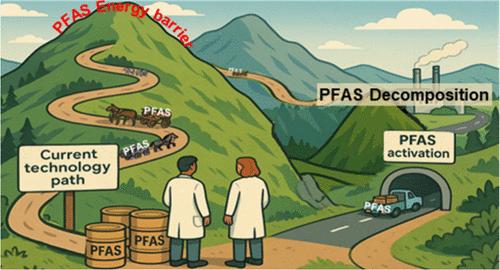激活PFAS解锁高效除氟
IF 11.3
1区 环境科学与生态学
Q1 ENGINEERING, ENVIRONMENTAL
引用次数: 0
摘要
全氟烷基和多氟烷基物质(PFAS)由于其C-F键的异常稳定性而对常规降解方法具有很强的抵抗力。因此,目前的降解技术往往依赖于高能量输入和添加剂的过度使用,而在很大程度上忽视了通过直接激活PFAS分子或离子来降低反应能垒的策略。这一观点通过强调PFAS分子的预降解激活,为PFAS降解提供了一个新的视角。我们系统地研究了一系列由催化剂表面络合、溶剂、盐和空气-水微界面促进的分子活化机制。这些方法通过拉长C-F键或改变表面电子结构和电荷分布来破坏PFAS分子的稳定性,从而克服激活障碍(ΔG‡),用于随后的除氟反应。此外,我们概述了未来的发展方向,包括多模态激活和新兴的数据技术,如智能反应堆设计和机器学习引导的优化,以弥合基本的分子见解和实际的工程应用。因此,分子活化为克服动力学和能量挑战提供了一条变革性的途径,为节能、经济、广泛适用的解决方案铺平了道路,以消除环境中这些持久的“永久化学物质”。本文章由计算机程序翻译,如有差异,请以英文原文为准。

Activating PFAS to Unlock Efficient Defluorination
Per- and polyfluoroalkyl substances (PFAS) are highly resistant to conventional degradation methods due to the exceptional stability of their C–F bonds. As a result, current degradation technologies often rely on high energy inputs and excessive use of additives while largely overlooking strategies that focus on lowering the reaction energy barrier by directly activating PFAS molecules or ions. This Perspective presents a new angle to PFAS degradation by emphasizing the predegradation activation of PFAS molecules. We systematically examine a range of molecular activation mechanisms facilitated by catalyst surface complexation, solvents, salts, and air–water microinterfaces. These methods destabilize PFAS molecules by elongating C–F bonds or altering surface electronic structures and charge distributions, thereby overcoming the activation barriers (ΔG‡) for subsequent defluorination reactions. Additionally, we outline future directions that incorporate multimodal activation and emerging data technologies, such as intelligent reactor design and machine-learning-guided optimization, with the goal of bridging fundamental molecular insights and practical engineering applications. Molecular activation thus offers a transformative pathway to overcome kinetic and energetic challenges, paving the way for energy-efficient, cost-effective, and broadly applicable solutions to eliminate these persistent “forever chemicals” from the environment.
求助全文
通过发布文献求助,成功后即可免费获取论文全文。
去求助
来源期刊

环境科学与技术
环境科学-工程:环境
CiteScore
17.50
自引率
9.60%
发文量
12359
审稿时长
2.8 months
期刊介绍:
Environmental Science & Technology (ES&T) is a co-sponsored academic and technical magazine by the Hubei Provincial Environmental Protection Bureau and the Hubei Provincial Academy of Environmental Sciences.
Environmental Science & Technology (ES&T) holds the status of Chinese core journals, scientific papers source journals of China, Chinese Science Citation Database source journals, and Chinese Academic Journal Comprehensive Evaluation Database source journals. This publication focuses on the academic field of environmental protection, featuring articles related to environmental protection and technical advancements.
 求助内容:
求助内容: 应助结果提醒方式:
应助结果提醒方式:


